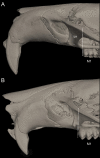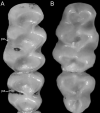Systematics and diversification of the Ichthyomyini (Cricetidae, Sigmodontinae) revisited: evidence from molecular, morphological, and combined approaches
- PMID: 36655048
- PMCID: PMC9841913
- DOI: 10.7717/peerj.14319
Systematics and diversification of the Ichthyomyini (Cricetidae, Sigmodontinae) revisited: evidence from molecular, morphological, and combined approaches
Abstract
Ichthyomyini, a morphologically distinctive group of Neotropical cricetid rodents, lacks an integrative study of its systematics and biogeography. Since this tribe is a crucial element of the Sigmodontinae, the most speciose subfamily of the Cricetidae, we conducted a study that includes most of its recognized diversity (five genera and 19 species distributed from southern Mexico to northern Bolivia). For this report we analyzed a combined matrix composed of four molecular markers (RBP3, GHR, RAG1, Cytb) and 56 morphological traits, the latter including 15 external, 14 cranial, 19 dental, five soft-anatomical and three postcranial features. A variety of results were obtained, some of which are inconsistent with the currently accepted classification and understanding of the tribe. Ichthyomyini is retrieved as monophyletic, and it is divided into two main clades that are here recognized as subtribes: one to contain the genus Anotomys and the other composed by the remaining genera. Neusticomys (as currently recognized) was found to consist of two well supported clades, one of which corresponds to the original concept of Daptomys. Accordingly, we propose the resurrection of the latter as a valid genus to include several species from low to middle elevations and restrict Neusticomys to several highland forms. Numerous other revisions are necessary to reconcile the alpha taxonomy of ichthyomyines with our phylogenetic results, including placement of the Cajas Plateau water rat (formerly Chibchanomys orcesi) in the genus Neusticomys (sensu stricto), and the recognition of at least two new species (one in Neusticomys, one in Daptomys). Additional work is necessary to confirm other unanticipated results, such as the non-monophyletic nature of Rheomys and the presence of a possible new genus and species from Peru. Our results also suggest that ichthyomyines are one of the main Andean radiations of sigmodontine cricetids, with an evolutionary history dating to the Late Miocene and subsequent cladogenesis during the Pleistocene.
Keywords: Amazon; Andean; Chibchanomys orcesi; Daptomys; Ichthyomyini; Neotropics; Sigmodontalia; Subtribes; Water rats.
© 2023 Salazar-Bravo et al.
Conflict of interest statement
The authors declare that they have no competing interests.
Figures








































References
-
- Alhajeri BH, Schenk JJ, Steppan S. Ecomorphological diversification following continental colonization in muroid rodents (Rodentia: Muroidea) Biological Journal of the Linnean Society. 2016;117(3):463–481. doi: 10.1111/bij.12695. - DOI
-
- Allen R, Ryan H, Davis BW, King C, Frantz L, Irving-Pease E, Barnett R, Linderholm A, Loog L, Haile J, Lebrasseur O, White M, Kitchener AC, Murphy WJ, Larson G. A mitochondrial genetic divergence proxy predicts the reproductive compatibility of mammalian hybrids. Proceedings of the Royal Society B: Biological Sciences. 2020;287(1928):20200690. doi: 10.1098/rspb.2020.0690. - DOI - PMC - PubMed
-
- Anderson S. Mammals of Bolivia, taxonomy and distribution. Bulletin of the American Museum of Natural History. 1997;231:1–652.
-
- Anthony HE. Preliminary report on Ecuadorean mammals No. 1. American Museum Novitates. 1921;20:6.
Publication types
MeSH terms
LinkOut - more resources
Full Text Sources

